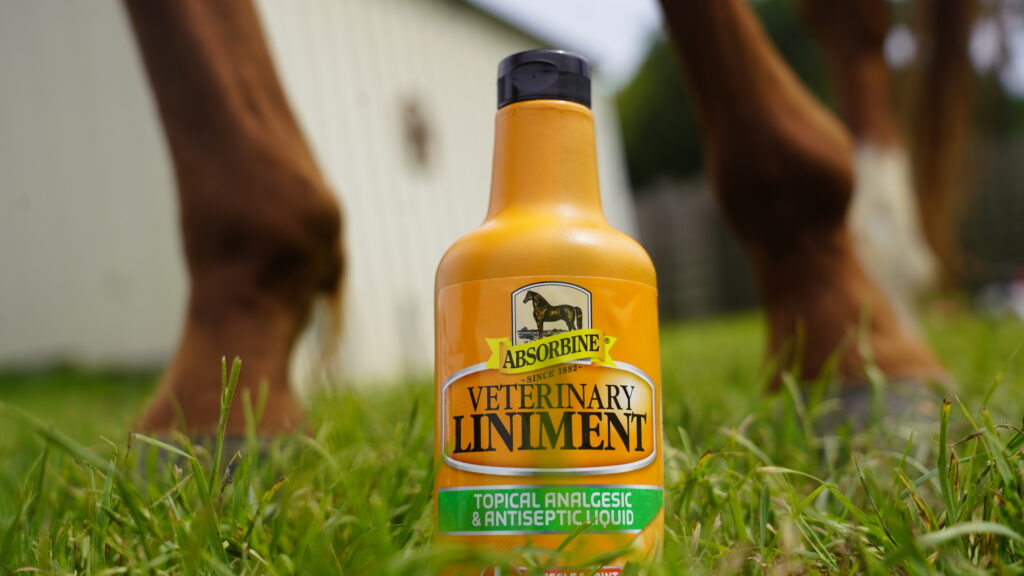In the world of barrel racing and equine care, the use of liniments has a long-standing tradition, but misinformation and common mistakes can vastly limit the products’ power when barrel racers are left to use the products in the wild.
Old-time horsemen relied on these liquid suspensions of herbal extracts to alleviate their horses’ aching muscles, tendons, and joints. These liniment recipes were treasured secrets, passed down from generation to generation. Today, liniments have evolved into advanced formulas that cater to specific needs and offer enhanced benefits for equine athletes.
When using liniment for horses, there are several common mistakes that horse owners may make. Being aware of these mistakes can help ensure the safe and effective use of liniments. Here are some of the most common mistakes:
Mistake No. 1: Incorrect application
A common mistake is not following the instructions provided by the liniment manufacturer. It’s important to apply the liniment as directed, including the recommended amount, frequency, and method of application (e.g., massaging, wrapping). Failure to follow the instructions may result in ineffective or potentially harmful use of the liniment.
Using liniments excessively or too frequently can be counterproductive. Some horse owners may mistakenly believe that more is better, leading to over-application of liniment. It’s important to adhere to the recommended dosage and frequency to avoid potential skin irritation or other adverse reactions.
Read: Flex On ‘Em: Understanding 7 Key Muscle Groups for Barrel Racing Horses
What is equine liniment and how does it work?
A high-quality liniment works by penetrating the soft tissues of the skin, opening up pores and capillaries to increase blood flow to the muscles. This surge of blood delivers essential nutrients while eliminating fatigue acids that contribute to muscle soreness. The increased blood flow facilitates healing, relieving pain in the process. Essentially, liniments support the horse’s own healing capabilities, aiding racehorses with tired tendons, hunters fatigued from fieldwork, cutting horses with tender backs, and even retired horses with arthritis, under the guidance of a veterinarian. Applying liniment to stiff joints and muscles before workouts can reduce pain and the risk of injury.
Formulations to Suit Your Needs: When considering liniments, temperature and method of application play a crucial role:
Warming Formulas: Ideal for alleviating stiff joints, sore muscles, and tendons, warming liniments such as Absorbine Veterinary Liniment and Bigeloil Liniment offer a soothing sensation. Massaging a warming liniment pre-workout can enhance flexibility, even in chronic cases.
(Courtesy Equus Magazine by Laurel Scott)
Cooling Formulas: Refreshing and invigorating, cooling liniments are perfect for hot days and post-workout applications. They provide relief during acute flare-ups of pain, heat, and swelling. Cooling liniments offer a pleasant cooling sensation, aiding in recovery.
Mistake No. 2: Mixing different liniments.
Mixing multiple liniments or using different liniments simultaneously can be risky. Each liniment is formulated with specific ingredients and concentrations, and combining them may result in unknown interactions or adverse effects. It’s best to stick to one liniment at a time unless specifically instructed by a veterinarian.
Mistake No. 3: Using expired or contaminated liniments.
Using expired or contaminated liniments can be ineffective or potentially harmful to the horse. Always check the expiration date of the liniment before use and ensure that the product is stored properly to maintain its integrity. Additionally, avoid cross-contamination by using clean hands or applicators when applying the liniment.

The Absorbine liniment story
One of today’s most popular and trusted liniments of choice on the martket is Absorbine Veterinary Liniment, which was invented by Mary Ida and Wilbur F. Young just before the turn of the 1900’s. Wilbur delivered cargo with a wagon and a team of horses. Mary Ida was an avid horse enthusiast and cared for all of their horses. Wilbur’s team of horses would get tired after long days of pulling freight and often would be too sore the next day to pull cargo as effectively.
In those days, it was common to “blister” the skin using a caustic agent if a horse had stiffness or soreness. This caused blood to flood the area, speeding recovery of the muscles and connective tissues underneath. Harsh and uncomfortable for the horse, this practice also necessitated two to three days of recovery. Deciding there must be a more humane way to relieve sore muscles, Mary Ida formulated a time-honored blend of aromatic and essential oils that remains a family secret to this day. The Youngs named it Absorbine Liniment.
It was a “medicine chest in a bottle,” because in addition to relieving sore muscles with little down time, the formula has powerful antiseptic properties that help prevent bacterial and fungal infections such as rain-rot, summer itch, tail itch and minor skin infections. There is even a recipe right on the bottle for making a body wash for your horse that refreshes, disinfects and washes away sweat and grime. The product caught on quickly, and the business grew.
Enter the 21st century, and modern liniments are better than ever. They’re also available in a wide range of formulas for specific purposes.
(Courtesy Equus Magazine by Laurel Scott)
Mistake No. 4: Inappropriate use on open wounds or sensitive areas.
Liniments should not be applied to open wounds, cuts, or areas of broken skin. These areas require specific wound care and should be treated under the guidance of a veterinarian. Similarly, some liniments may contain ingredients that can be irritating to sensitive areas such as the eyes, nose, or mucous membranes. Avoid contact with these areas during application.
Mistake No. 5: Failing to seek veterinary advice.
While liniments can be beneficial for many horses, it’s important to consult with a veterinarian before using them, especially if the horse has underlying health conditions, is on medication, or is experiencing persistent or severe pain. A veterinarian can provide guidance on the appropriate use of liniments based on the horse’s specific needs.
For more information on Absorbine and their full line of products, click here.





